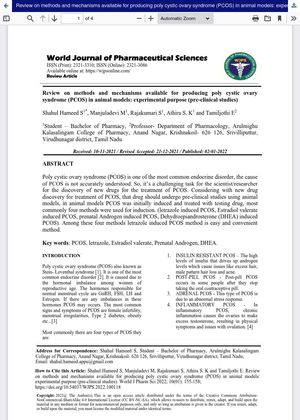Review on Methods and Mechanisms for Producing Polycystic Ovary Syndrome (PCOS) in Animal Models: Experimental Purpose (Pre-Clinical Studies)
January 2022
in “
World journal of pharmaceutical sciences
”

TLDR The document concludes that there are multiple ways to create PCOS in animals for research, which helps understand and treat the condition.
The document reviews various methods and mechanisms for inducing Polycystic Ovary Syndrome (PCOS) in animal models for experimental purposes. It discusses several techniques, including the use of hormones like testosterone and estradiol, diet-induced obesity, and exposure to constant light. These methods mimic the hormonal imbalances and metabolic disorders seen in human PCOS. The review also highlights the importance of these animal models in understanding the pathophysiology of PCOS and in the development of potential therapeutic strategies.



